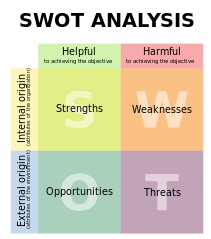“Vision without execution is hallucination” – Thomas Edison
 We were having an internal strategy planning session for one of our newer clients, and things were going great, when one of our account executives said “All of this stuff is great but if the program doesn’t get implemented like it’s supposed to, it’s going to be considered a train wreck.” How true, how true.
We were having an internal strategy planning session for one of our newer clients, and things were going great, when one of our account executives said “All of this stuff is great but if the program doesn’t get implemented like it’s supposed to, it’s going to be considered a train wreck.” How true, how true.
You see, developing “strategy” is fun on so many levels. It takes thought, understanding, sensitivity to the marketplace, and creativity to come up with a really good strategy. It’s found everywhere and so everyone wants to get in on that fun. You have MBA courses that emphasize strategy. As marketers we’re concerned with social media strategies, mobile marketing strategies, customer experience strategies, advertising strategies, online strategies, acquisition and retention marketing strategies, sales strategies, and so on and so on. In fact, any time two or more people in marketing get together, they discuss strategy. A well-crafted strategy is critically important to the success of any marketing initiative, right?
But the most vulnerable part of strategy is the implementation. To deliver results that we as marketers want, we have to find a way to give strategy a life beyond the paper on which it was written and without implementation, even the most dazzling strategy is just words on a page…a hope…an unproven idea. While we all know this to be the case, we don’t necessarily follow through on that knowledge. You see, too many times, implementation is delegated to one of the junior member of the team or to “specialists” who might not appreciate where their role fits into the whole.
I think we all understand that someone has to do the hard work that puts a strategy into the marketplace. But by the same token, we can’t just assume that everyone who is working away in the trenches on their tactics is actually supporting the overall marketing and business strategy that was created. We can’t just assume that implementing the various pieces of the program is the same as implementing it in the right way in order to achieve the company’s marketing and business objectives.
We’ve seen implementation snafus, some more legendary or awful than others. From companies running ads for their products that drew people into stores only to find that the product hadn’t arrived. Or a major bank announcing a new customer loyalty program but hadn’t explained the plan to its branch managers. Or, as happened with me this past year, a athletic shoe manufacturer sent me email after email telling me to stop by their upcoming trade show booth and by turning in a printed copy of the email, I would receive a certificate for significant savings off on their athletic shoes. Guess what happened when I showed up at the booth? Yup, no one, and I mean no one at the booth knew anything about the offer. “Don’t know what this is all about” or “No one told us about this” was said over and over again. So in effect, all the strategy development to get my attention and have me purchase a pair of their shoes (admittedly, at a discount) came crashing to the ground with a large thud.
Poor coordination and communication, and a poorly implemented strategy has led to as many market failures as a poorly conceived strategy…maybe even more. As well, too often, marketing is criticized for not having measurable indicators of effectiveness and success. Too often, marketers have taken the easy road, measuring their likes, followers, or the number of comments they get on Facebook or other social media. These metrics simply measure tactics. But the measure of a strategy’s success is, quite simply, in the revenues. And those revenues are directly affected by how the strategy is implemented.
Today’s marketing executives must manage the organization’s marketing operations and not just oversee them. It’s where the fundamentals of how the various tactics work together (or don’t) that marketing success will be determined. Simple implementation is not all that difficult. Implementing cohesively (getting everyone on the same page with the same level of commitment) is the hard part.
For those leading the marketing operations of their organizations, remember that it’s not just about the strategy. You can have the best strategy, you can even frame it and put it up on the wall, but if you’re not executing correctly…it’s just artwork.
####
Rolf Gutknecht is vice president, director of account services for LA ads. To discuss your thoughts with Rolf on this blog or any marketing matters, email via this link, or visit www.LAadsMarketing.com. You can also connect with Rolf on LinkedIn.
“Life can only be understood backwards; but it must be lived forwards.” – Soren Kierkegaard
 The last quarter of 2013 is almost history and as we stand poised to welcome 2014 in just 50 days from today, we hope for a future that is successful, rewarding and where dreams will be realized. Having seen the start of more than a few “new business years” during my career, I’ve learned that you can do one of two things in preparation for the coming year. You can yet again try to create a brand new marketing strategy for the coming year or you can pause, look back and do some serious reflecting, resolving to change, or improve some aspect about how you will initiate your future marketing campaigns. For some people, looking back over the past year may be something better left in the rearview mirror; on the other hand, burying your head in the sand can be seen as the primary ingredient in a recipe for another disappointing year…and you know how much the CEO/President/Owner/ Founder loves that kind of thinking and pending poor results. So before one celebrates the dawn of a new year…take time to ask yourself what are you going to do to change? What does success in 2014 look like to you and your executive management team?
The last quarter of 2013 is almost history and as we stand poised to welcome 2014 in just 50 days from today, we hope for a future that is successful, rewarding and where dreams will be realized. Having seen the start of more than a few “new business years” during my career, I’ve learned that you can do one of two things in preparation for the coming year. You can yet again try to create a brand new marketing strategy for the coming year or you can pause, look back and do some serious reflecting, resolving to change, or improve some aspect about how you will initiate your future marketing campaigns. For some people, looking back over the past year may be something better left in the rearview mirror; on the other hand, burying your head in the sand can be seen as the primary ingredient in a recipe for another disappointing year…and you know how much the CEO/President/Owner/ Founder loves that kind of thinking and pending poor results. So before one celebrates the dawn of a new year…take time to ask yourself what are you going to do to change? What does success in 2014 look like to you and your executive management team?
Speaking for myself and our firm, the end of each year is met with a healthy dose of optimism for the coming year. We see 2014 through a lens of hopefulness, that things will indeed get better. Is that just us or will you and your organization also view the coming year with a level of anticipation that you haven’t had for a few years? Hey, it’s been tough for most everyone out there but let’s remember that at least a few organizations — perhaps your own competitors — have fared better than most despite these trying times. So what have they done to plot a course for a more optimistic and profitable path for success in 2014?
Depending on marketplace factors coupled with how well you were able to strategically position and market your company, the past year was either seen as a success or another year of disappointment. Success if you were able to grow your share of the proverbial pie (maybe at the expense of your competitors) or be sufficiently positioned to stay in business to fight the fight for another year. Or disappointment if things didn’t turn out so well because of…(you can fill in the blank). The question that begs to be asked here is, how much of last year’s success or disappointment was because of something you had no control over, such as good luck or bad luck, and how much was because of something you did or didn’t do given how the marketplace presented itself? I’ve found through personal experience this is the time to be totally honest with yourself. As the quote goes: “Being entirely honest with oneself is a good exercise.” – Sigmund Freud
Hey, I’m all for a bit of luck but you probably don’t want to continue betting future success on lucky things happening in the coming year. With this in mind, here are a few questions to ask yourself as thought starters as you begin the process of looking in the rearview mirror to last year and through your windshield to the next:
As marketers, one thing we know for sure is that change will not stop in 2014. The economy will continue to shift on us —hopefully with less drama. But by reflecting back on 2013, taking control of your marketing activities rather than being tossed around by the waves in the marketplace, along with thinking optimistically about what 2014 can hold, 2014 might actually be a year worth celebrating. It will be for us and hopefully will be for you as well.
####
Rolf Gutknecht is vice president, director of account services for LA ads. To discuss your thoughts with Rolf on this blog or any marketing matters, email via this link, or visit www.LAadsMarketing.com. You can also connect with Rolf on LinkedIn.
 When it comes to sharing on social media, there’s you and your network of friends and contacts. These are all the people that you’re connected with on LinkedIn, Facebook, Twitter, email, etc. And like you, these people have their network, in other words, your network’s network. The big secret of social media, not just for your personal brand but for your company is that it’s not about your network per se. It’s not even so much about reaching those in your network. It’s about reaching your network’s network.
When it comes to sharing on social media, there’s you and your network of friends and contacts. These are all the people that you’re connected with on LinkedIn, Facebook, Twitter, email, etc. And like you, these people have their network, in other words, your network’s network. The big secret of social media, not just for your personal brand but for your company is that it’s not about your network per se. It’s not even so much about reaching those in your network. It’s about reaching your network’s network.
So every message you put out there should be something that your network wants to forward. If your network doesn’t want to forward it along to their networks, then your brilliant post or exciting news dies with them. It’s like telling a room full of people you know something wonderful that you would hope they would tell others…but the word never gets out. On the other hand, if you put out content that’s surprising, that teaches, that adds to the conversation, that provokes thought, that taps into a bigger discussion, then people will forward it. In a sense, they reward you for being oh so clever and smart.
For example, I’m of that age where I’m taking more of an interest in insurance-related matters, so I’ve found myself going to New York Life’s Facebook page. There they ask questions, have polls, allow you to fill in the blank on things that directly have to do with insurance; but many other times the content is peripheral – what do you want your legacy to be? How old is the oldest person you know and what makes them special? It’s stuff people comment on a lot. As you may know, what happens then on Facebook is that those comments show up on people’s individual pages as commenting about something on New York Life’s page. So it becomes viral… which is the art of reaching your network’s network.
So what kind of messages are likely to be forwarded, or maybe more importantly, what kind of messages are boring and least likely to be forwarded? Well one kind is the “cat” status update kind you find on Facebook. You know…”I just fed my cat.” “My cat is playing with her new toy.” Cat, dog, people, whatever. We all know this stuff hardly ever gets forwarded. But you know what, brands do the equivalent of “I just fed kitty” updates all the time. How many times have you read “we just got a new product,” or “we’re moving, ” or “our company just hired 10 more people,” “we just painted our building,” etc. Yaaaawn. While it’s not at all wrong to give out that info, just know you’re saying something about yourself that’s not adding value and thus this update goes no further than your immediate circle of connections, if they’re paying attention at all. Oh, and then there’s the type of messaging that you find on LinkedIn and Twitter a lot…the over-populating of meaningless updates and posts without cessation. One post or tweet after another to the point you get tired seeing this person’s face show up on your screen ever again! If the idea of social media marketing is to form relationships with people, then why would you want to undo what you’ve accomplished by over-marketing your company to the point where people say, “I’ve had enough. Buh-bye!”
So what kind of messages generate traffic for business and does get forwarded to your network’s network? It turns out you already saw this in high school when a message of great personal value went out there and was forwarded. I’ll call this “My parents are out of town…bring your own beer” message. This type of update breaks through the rest of the “ho-hum” messages because it does two things: it produces a high emotional response and people like sharing practically useful content to help out their friends, as well as business customers or prospects.
Now I’m not a psychologist but I’ve found through personal experience that the likelihood of sharing content seems to hinge on things that produce an emotional response by means of wonder, joy, anxiety, fear and surprise. I’m sure there are many other motivators but let’s just talk about these for a moment.
As we know, the idea of social media is to create and strengthen relationships with people. We do that by sharing information that they’d like to get, read and pass along to others. That doesn’t happen if what you have to say isn’t interesting and you won’t be interesting until you say and do things imaginatively, originally, freshly.
 When I first started out in this crazy world of advertising and marketing, I had a co-worker who had been in the business for a while (think of the show “Mad Men”) who would pass on “things to know” in endless supply. One of those things that I’ve remembered over the years has to do with the difference between knowledge and wisdom. It goes like this: knowledge is knowing that a tomato is a fruit; wisdom is knowing that you shouldn’t put it in a fruit salad. I’ve said this so many times to friends, co-workers, my kids, etc., that I’m surprised I’m still not tired of saying it. But there’s so much truth in it and it applies especially to the discipline of marketing.
When I first started out in this crazy world of advertising and marketing, I had a co-worker who had been in the business for a while (think of the show “Mad Men”) who would pass on “things to know” in endless supply. One of those things that I’ve remembered over the years has to do with the difference between knowledge and wisdom. It goes like this: knowledge is knowing that a tomato is a fruit; wisdom is knowing that you shouldn’t put it in a fruit salad. I’ve said this so many times to friends, co-workers, my kids, etc., that I’m surprised I’m still not tired of saying it. But there’s so much truth in it and it applies especially to the discipline of marketing.
As marketing folks, regardless of the industry or size of the firm or marketing department, we’re busy trying to learn as much as we can so as to stay up with the times. And there’s so much to learn. Whether it’s new research telling us about how certain demo groups are behaving towards specific marketing channels, to new online tools, to the best lead-generation software, it’s all coming at us at lightning speed. But we have to remember the need to use good judgment given all of this knowledge. You see knowledge – having specific familiarity or understanding about something – is a bit different than having wisdom – being able to discern or judge what is true, right or lasting. In short, to be wise.
So, while all of this knowledge is important — and it is — we need to know what we can depend on and what is just a fad. What will apply tomorrow after “the next best thing” in marketing has burned out and we’re on to the next “next big thing.” So indulge me in the passing on of some marketing wisdom. Think of it as Marketing “Chicken Soup for Soul,” if you catch my drift.
Marketing wisdom is knowing…
So, when you open up your next Google Alert about a specific marketing subject or if someone from upstairs decides to drop off an industry trade journal with a Post-It note saying “maybe we should try this,” it might be worth remembering “Marketing wisdom is knowing what to put in your fruit salad or keep out of it.”
####
Rolf Gutknecht is vice president, director of account services for LA ads. To discuss your thoughts with Rolf on this blog or any marketing matters, email via this link, or visit www.LAadsMarketing.com. You can also connect with Rolf on LinkedIn.
“The truth isn’t the truth until people believe you, and they can’t believe you if they don’t know what you’re saying, and they can’t know what you’re saying if they don’t listen to you, and they won’t listen to you if you’re not interesting, and you won’t be interesting until you say and do things imaginatively, originally, freshly.” – Bill Bernbach
Over the past couple of weeks, in both my personal and business life, it just seems like everywhere I turn, I’m seeing the most uninspired, blah, boring, and unenthused advertising and marketing messaging. From credit unions to food products to retail delivered through TV, direct mail, outdoor, one-sheets/brochures, whatever. You know exactly what I’m talking about. It’s as though A LOT of people got the same memo: create only lifeless, sigh-inducing marketing that doesn’t say anything. As a result, I recall something that the comedian Billy Connelly once said about people who create this kind of stuff. He called them “Beigests” – as in the color beige.
For the purposes of painting a picture of who a “Beigest” is, let’s describe them as constantly striving to turn everything around him or her lukewarm and mediocre. The kind of person who’ll suck the life out of all meaningful messaging, attempt to censor or dilute anything that they don’t get (forget that their audience does get it), water down any sort of strong rationale with weasel words & steer it towards the middle, and constantly strive for “consensus” as they make the world “user friendly” (i.e., rather than make an executive decision, they ask everyone for their opinion. I sometimes wonder if people making the advertising or marketing decisions are genetically incapable of recognizing messaging that stands out, that they simply default to that never vibrant but never offensive color beige.
Let me ask: who loves the color beige? Not many people will respond saying that beige is one of their favorites. But it’s a color, right? So why aren’t more people expressing their love for it…like they do for reds, blues, purples, or whatever your favorite color is. Because beige is insanely boring! It totally lacks enthusiasm which makes the marketing messaging as dull as an accountant’s office.
Our lives are way too busy for us to be attracted to “beige” things. Yet, too many marketers don’t project that same line of thinking toward attracting customers. Decisions are made daily to keep producing and running the same run-of-the-mill, uninspiring stuff…week after week, month after month, year after year.
Keep in mind that when you as a consumer see anything from a company, either your opinion of that company is enhanced or it’s not. There’s no middle ground. You either like them a bit more or you go in the other direction. So, if that’s the case, why do too many marketers turn that compelling, money-making value proposition into a beige “me-too” that each and every one of your competitors could say. Why do you think for one second that someone is going to acknowledge your message? And not only acknowledge it, but take the time to respond, and make a purchase.
I don’t know about you, but I’ve never been bored into buying something. And I’m even going to say that 99% of your customers are with me on this. The marketing you do for your company is an extension of you. You’re the person who’s responsible for communicating the passion of your company. When you talk about your business with others, hopefully your eyes twinkle, your heart begins to race, your voice becomes more dynamic and people are instantly attracted to you. When that show of enthusiasm and excitement happens, no one would confuse you with being boring, right? Of course not. So look at your marketing stuff and see if it reflects that same level of specialness. Or you could always ask friends, colleagues, suppliers or anyone who will be candid with you, “Does this marketing make you want to pick up the phone and call us or know more about us?” If the answer is not an enthusiastic “yes,” then it’s time to start over. Because spending money that can’t produce results never makes CEOs happy. They’re eventually going to see what you produced for the market.
Save your company from being seen as beige. Be a welcomed splash of red. And listen, not only is it possible for you to create a business that is as fascinating as you are, it is necessary. Life’s too short to settle for “blah.”
 As an agency who is always looking to team up with marketing-centric, growth-oriented companies, I’m constantly baffled by the number of prospective clients who tell me that their competitive edge is that “we’re honest,” or “we care about our customers,” or “hey, we’re very good at what we do.” The next obvious question then is how many of their competitors say they are not very honest, they don’t really care about their customers, and they’re not very good at what they do?
As an agency who is always looking to team up with marketing-centric, growth-oriented companies, I’m constantly baffled by the number of prospective clients who tell me that their competitive edge is that “we’re honest,” or “we care about our customers,” or “hey, we’re very good at what we do.” The next obvious question then is how many of their competitors say they are not very honest, they don’t really care about their customers, and they’re not very good at what they do?
We’ve all gotten so wrapped up in what we perceive to be our strengths, what we “know” the market wants, what the reasons are that customers purchase our products and services (or at least should do) that we are in danger of not seeing the forest through the trees. We spend our time thinking up strategies, putting time against newer ways of reaching customers and prospects with the ever-increasing tactics of social media, etc. But we seldom, if ever, take the time to stand back and reflect where the company stands in the real-world, as the marketplace sees us.
As marketers, we know the importance of doing a SWOT analysis – Strengths, Weaknesses, Opportunities, and Threats – usually before companies rebrand themselves or new products are launched. SWOT needs to be a central part of our marketing efforts before the strategy development, before the tactical implementation, before undertaking new methods of communicating and measuring the effectiveness of our communications. In fact, when was the last time your organization or your marketing partner put together a brutally honest, no-holds-barred SWOT analysis? If you’re like most, it’s been a while.
In larger companies, marketing departments have annual planning cycles. In smaller companies, the routines are not as formalized, and planning has a tendency to be less frequent and with less time devoted to it. Generally this process looks more at budget allocation, new initiatives to be considered or implemented, staff/services cut-backs, etc. But hardly ever (ok, with less frequency than one would think) does this planning examine not just the strategy and tactics employed but how marketplace changes may have changed the company’s strengths, opportunities, weaknesses, and threats at the most basic level.
This needs to be done on a regular basis before time and resources (financial, staff, etc.) are committed to a strategy, an approach, or new tactics. Important questions need to be asked, and too often the most basic questions are not asked.
We all know them: What are our strengths? Are the strengths recognized by customers and prospects? Do our competitors have the same strengths? What are their strengths? And so on. How has the marketplace changed? Where are the new opportunities? Are our products/services adversely affected by emerging trends? How are our competitors reacting to the changing marketplace? Etc.
So I am NOT suggesting that the Marketing Department doesn’t know how to approach the marketplace or that we don’t know what we need to know. I am, rather, suggesting two things:
1. We need to set aside some time, on a regular basis, to carefully put all these questions and the answers together, and only then plan, create the strategy and implementation tactics.
2. We need to test our assumptions – every time – against what is happening in the real-world, on the ground, where the customers live and where our revenues come from.
With everything on Marketing’s plate today, and the urgency in which it needs to get done, there’s a real danger of losing sight of the basics. Who has the time, right? Well, if we lose sight of the need to regularly and carefully look at what we think our company is (warts and all), look at all that we do, and all the resources we use/spend, in the ever evolving marketplace – not just our guesses about it and our customers – we risk losing all that we work so hard to achieve: increasing revenues and market share.
The time tested marketing adage of “If you don’t really know where you are, it is much more difficult to get where you want to be” has never been more true.
 Over the weekend, my daughter wanted to update the look of her bedroom to reflect, as she told me on more than one occasion, …the “new her.” Well, as we finished painting and as she started moving the furniture around and bringing new stuff into the room as well, it occurred to me that she was just “refreshing” the look of the room and not “rebranding” who she was as a person. You see, while the color of her room had changed, a lot of other things remained the same because they spoke to who she is and what’s important to her. And the same thing holds true for companies…maybe yours, as well.
Over the weekend, my daughter wanted to update the look of her bedroom to reflect, as she told me on more than one occasion, …the “new her.” Well, as we finished painting and as she started moving the furniture around and bringing new stuff into the room as well, it occurred to me that she was just “refreshing” the look of the room and not “rebranding” who she was as a person. You see, while the color of her room had changed, a lot of other things remained the same because they spoke to who she is and what’s important to her. And the same thing holds true for companies…maybe yours, as well.
And herein lies the question: When the need arises, should you be rebranding or just refreshing your brand?
As we know, rebranding your business can be an intensive process that can literally redefine a company from the ground up. It’s more than just slapping on a new coat of colors. Instead, a rebrand is a complete redo of an already established brand because the brand has become somewhat stale, insignificant, or are just dated. This often happens when the brand has been around for a while, regardless of size or industry. Contributing factors include: aggressive competition, becoming “lost in time” with an aging customer base, or industry changes that begin to turn a company’s brand irrelevant.
However, rebranding a company from the ground up might not be the best bet for several reasons. For one, rebranding a company tends to erase history in the mind of the customer and you not only run the risk alienating current customers but confounding prospective customers. Oh, and don’t forget about the money that’s involved. Still, for many businesses, it’s necessary in order to stay competitive.
However, it is possible to take a small-scale approach by simply refreshing your brand. Think of it as remodeling your home. It’s still the same house that keeps you safe and warm; you’re just replacing the dark brown shag carpeting with hardwood floors and the yellow tile countertops with granite. It’s more of a remodel of your existing brand than a complete rebuild.
Ok, so why should you be considering this option? Well, if your company has been around for a while, maybe it’s time to revitalize your dated look, or make it more appealing to a contemporary audience, or target a new audience, or address current market conditions. This involves revising/reinvigorating a brand’s positioning and branding imagery to ensure that the messaging is not only strategically sound, but that the brand’s look is up-to-date while still keeping much of the brand’s equity. In short, it’s less of an overhaul, and more of a clarification. The brand name is left untouched, but there are changes in the logo design. Maybe it’s the sizing, placement and type of images and graphics to be used or additional shades of brand colors. It could be a new look to your website, packaging or a change in the tagline.
With this in mind, here are five things are worth considering:
Refreshing your brand is no walk in the park. It takes a lot of preparation and hard work to do it right, but it can help to ensure your brand stays fresh and continues to resonate with your customers. What better way to say “hey, we’re changing with the times” than to refresh your company image.
 Businesses everywhere are searching with ever-increasing frenzy for the wonder drug that’s going to help their businesses do more sales. A few years ago it was search engine optimization. Today it’s social media marketing. My take on this is to do your company a favor and save your money because using social media as a pathway to sales is almost certainly not going to work to the degree you want. What? Heresy you say?
Businesses everywhere are searching with ever-increasing frenzy for the wonder drug that’s going to help their businesses do more sales. A few years ago it was search engine optimization. Today it’s social media marketing. My take on this is to do your company a favor and save your money because using social media as a pathway to sales is almost certainly not going to work to the degree you want. What? Heresy you say?
You see, while social media can be a valuable marketing tool, it’s not magic, it is not a miracle, and it cannot and won’t replace everything that came before it. By itself, social media doesn’t work well. I realize what I’m saying is not likely to be well-received, especially with the hundreds of people who have set themselves up as social media experts over the last year. I can understand why people think social media will cure everything, but I challenge anybody reading this to produce a real success story that has led to an actual increase in sales.
Just take a look at the top brands on Facebook (www.fanpagelist.com/category/brands) to see which brands people Like and Follow on Facebook and Twitter respectively. It’s hard not to be amazed. The #20 brand (Skittles) has more fans than there are people who live in Texas! Yup…Texas. Wow! Who needs paid media when you can reach a mass audience for free? Surely that’s an opportunity just too good to miss, right? Surely it makes sense to place a chunk of your limited and stretched marketing budget on a social media expert who promises to get your message out there so that the profits will roll in. Right?
Well, hold on for a reality check. One significant fact is that most of the top social brands continue to invest heavily in traditional media. Coke is near the top of the top brands on Facebook with more than 70 million followers. WalMart has over 30 million. The route to social media success, it seems, runs through traditional channels. Even the exceptions like YouTube and Starbucks are worth looking at. They obviously didn’t grow into superstar brands using Facebook and Twitter but rather use social media to capitalize on brand equity they have already built-up. In fact, when Google started getting serious competition, they started running TV ads. When there’s a product launch, a sale or just about any other occasion where you need to reach a mass audience quickly and effectively, there’s still no substitute for paid media…and the dot com’s know it.
Social media is a long, hard row to hoe. There’s no quick success and very few programs break through. Ask any company in the country and they’ll tell you they have some kind of social media program in place. Some of the more active companies write a few blog posts a week; reply to comments and questions on a daily basis; and update their Twitter and Facebook feeds repeatedly. A tiny, tiny proportion of them are having anything that resembles significant impact. Fact is, Coca-Cola says it can find no correlation between “buzz” on Twitter and actual unit sales. Auto manufacturer Nissan admits it has no idea if social media helps it shift cars. MasterCard can’t tie its social investment to revenues. In fact, there remains little evidence social media does anything to boost brands’ bottom lines.
Our firm’s experience has been pretty much the same. Although LinkedIn groups were helpful in the beginning, Facebook and Twitter were almost useless for the first year. It took awhile to build a following and learn how to develop it before we saw any benefits that justified the effort.
Oh, and let’s not forget about that group of mysterious online people out there that supposedly hold all the cards … the “Influentials.” Tap into them and they’ll disperse your message to the masses, or so some would have us believe. The fact is that in-depth research into the matter finds this whole idea completely baseless. Brands like Apple, Harley Davidson and Trader Joes, for instance, have been able to build an army of passionate followers without an “influencers” strategy.
That doesn’t mean that influence doesn’t exist. It does. TV show host Oprah Winfrey is very influential as doctors are when it comes to health issues, clergy for spiritual issues and so on. However, there’s nothing mysterious about them. Marketers have long used celebrity endorsements, trade marketing and community outreach where appropriate. The truth is that brands are not built by influential people, but by influential ideas. The problem is that so called “influencers” aren’t that much more influential than anybody else. Don’t take my word for this. Go online and do your own research and see for yourself.
Again, social media by itself is not a great way to build a brand. You’re just inserting yourself into an ocean of jumbled voices and are unlikely to stand out. Marketers like to complain about the clutter in traditional media, but in social media it’s so much more cluttered.
So then why use social media at all? The reason is that it is an impactful vehicle for empowering advocacy and we know that’s extremely important for brand health and profitability. Social media, if done right, can capitalize on what brand equity your company has already built up.
So when I hear social media “experts” who make outrageous claims, who state misleading research, who use everything from stories to rumors to masquerade as facts, whose bias renders them short of perspective, and who completely dismiss the power of ‘traditional’ advertising… they’re ONLY, ONLY, voicing their opinion and not “showing me the beef.”
While social media is a vitally important component of an overall effort, it’s no replacement for sound marketing principles.
 A few weeks ago, I was faced with needing to find a new dentist. So, the search began and the more I looked around, the more it showed just how many touchpoints came into play prior to – and after – a selection being made.
A few weeks ago, I was faced with needing to find a new dentist. So, the search began and the more I looked around, the more it showed just how many touchpoints came into play prior to – and after – a selection being made.
As we know, customers experience your brand in numerous ways and each of these touchpoints molds the customer’s impression of your company’s brand. If the brand is a promise you make, then the customer experience is the fulfillment of that promise. The customer experience can’t be left to chance. It has to consistently reinforce the brand promise across every customer touchpoint or the value of the brand itself is at risk.
So, after thinking about what your brand stands for and what sets it apart, it’s time to look outward. After all, if a brand is built and nobody hears it, does it make a sound? In not-so-distant marketing past, reaching consumers meant connecting through just a few channels: a catalog, a radio spot, a store visit, a customer service line, a salesperson…You get the idea. However, the number of channels for reaching customers has exploded in recent years. Think about it: when was the last time you made a major (or even not-so-major) purchase decision, personal or for business, whether a product or service, through a single channel? In fact, it’s more likely that your purchasing decision was made after being reached through a variety of interconnected touchpoints, from social media, to word-of-mouth, to advertising messaging, to conducting research online, to comparison shopping in the store.
Despite the desire to “silo” marketing channels, they’re far more effectively used together than individually. In a Forrester’s research report, it was noted that 33% of new customers involve two or more “trackable touchpoints,” and nearly 50% of repeat customers visit three or more “trackable touchpoints.” And despite the fact that nearly a 50% of the surveyed people believed that social media channels are a great place to discover new products, less than 1% of sales resulted directly from a social media referral. Online search (i.e., Google) and email were much more effective at closing a sale.
That said, your ultimate goal is to have each touchpoint reinforce and fulfill your marketplace promise. The best way to do this effectively is to look at each of your marketing, selling, and servicing processes which then allows you to create a simple touchpoint chart or map that defines your customers’ experiences with your brand.
Keeping this in mind, let’s use the process in looking for a new dentist:
That said, all touchpoints are not created equal. Some will naturally play a larger role in determining your company’s overall customer experience. To determine the touchpoints driving your customers’ overall experience, your organization can use a wide array of techniques ranging from quantitative research to institutional knowledge.
Yes, it’s simple….almost absurdly simple. But stepping into consumers’ shoes is an exercise absolutely too many executives neglect when marketing. We forget to become our own customers–with real, day-to-day concerns–and in the process, we lose sight of the most valuable touchpoint opportunities. Each one is a chance to present your brand and what you stand for.
In other words, having a more refined sense of “touch” has a big impact on how your prospects feel.
 What does this popular country song by Johnny Lee have to do with this blog post? Well, this week my neighbor received a really attractive offer from a company with whom I’ve had a long standing relationship. When I called the company and asked if I could get the same offer, I was told “Sorry. That’s for new customers only.” When I then asked what offers did they have for current customers, I was told they’d get back to me on that. I have yet to hear from them.
What does this popular country song by Johnny Lee have to do with this blog post? Well, this week my neighbor received a really attractive offer from a company with whom I’ve had a long standing relationship. When I called the company and asked if I could get the same offer, I was told “Sorry. That’s for new customers only.” When I then asked what offers did they have for current customers, I was told they’d get back to me on that. I have yet to hear from them.
So, with that in mind, have you noticed how many companies offer deals only to new customers? Sign up for our new program and the first month is free! Special gift for new customers only! Try our new product and we’ll give you more than you asked for! Here’s the problem with those type of offers: They focus on new customers and not the ones you already have. As a loyal customer of that business, it would be nice if you could take advantage of some of those special offers too. Trouble is that they’re for new customers only. You, on the other hand, have been supporting the business for years but you get nothing. Nothing for your dedication and loyalty.
Most people think that growing a company’s sales means getting new customers. Well, yes and no. Yes, new customers are constantly needed, but truly successful companies prosper on their ability to keep the customers they’ve already acquired. The reason is simple. Finding new customers is expensive and time consuming. For example, let the following research statistics wash over you….
Not to mention that current customers give invaluable feedback on “how we did” or “how the product/service is doing” along with being a major source of referrals, etc. That’s why losing a good customer to the competition is always a bad thing. You have to work more than 10 times as hard to get enough new customers just to make up the revenue lost with your departing one, and forget about profit.
Which brings me to the question that begs to be asked: “Why do customers leave?” Curiously, most business owners and managers have the exact wrong idea about why customers leave. Most people believe that customers leave because:
(Drum roll please)…Wrong!
According to an in-depth study by the research firm CRMGuru, the reasons customers give for taking their “business down the road” are:
As you can see, when it comes to keeping your existing customers, customer service is 3 times more important than price–and 5 times more important than functionality. Which obviously means that if you want to keep the customers that you’ve got, you should think about reversing priorities and pay more attention to customer service and quality–and, consequently, less attention to functionality and price. I fully realize that this runs contrary to 90% of what most people think is important, probably because price and functionality can play a large role in new customer acquisition.
So what can be done to maximize the value of your most valuable asset? Here are five quick thought starters:
Regardless of what you’re selling, your long-term profitability is largely dependent upon your ability to keep current customers, rather than acquiring new ones. While it’s fine to try things to attract new customers to your business, be sure to spread a little love around to those who are already in your camp and are supporting your business. Don’t forget, every now and then, to “dance with the one that brung ya.”